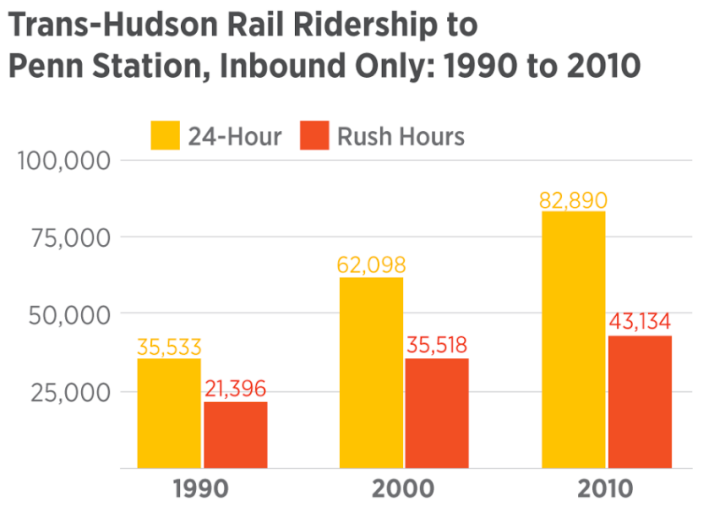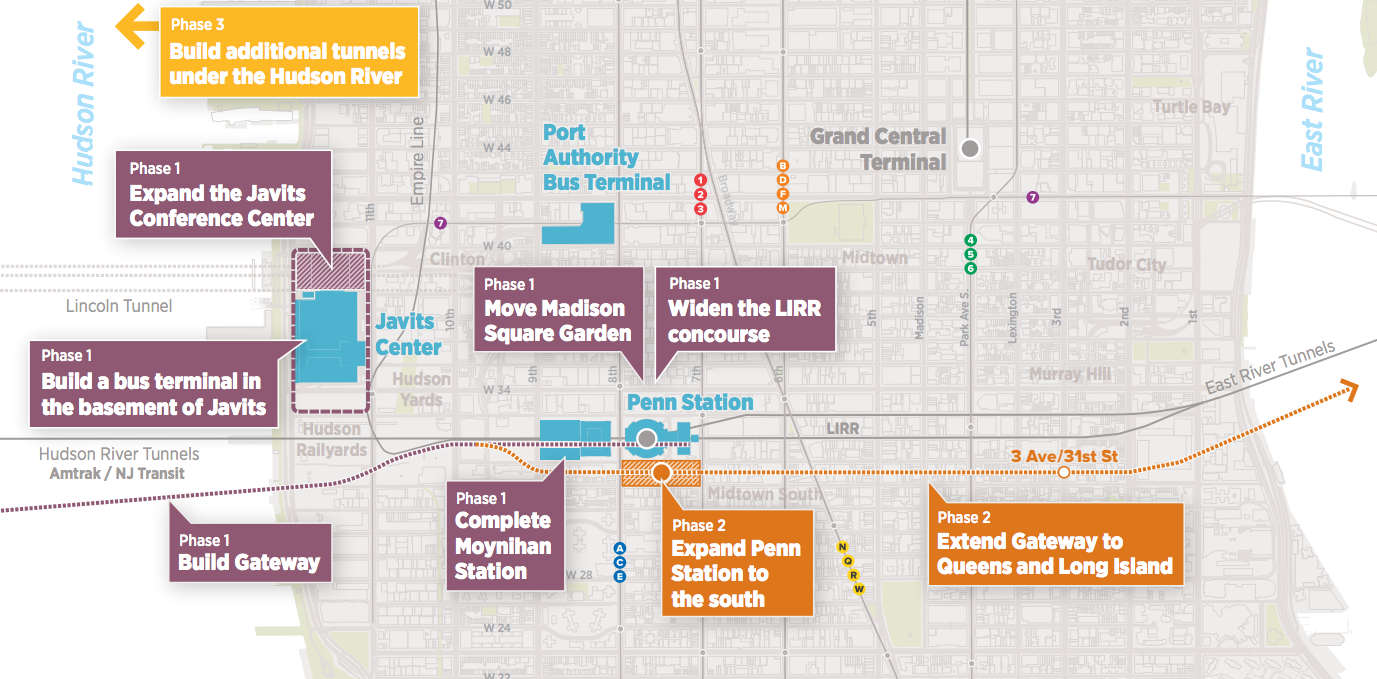Transit capacity across the Hudson is at a breaking point. As more people living in New Jersey find work in New York City, regional officials are in a race against time to replace and upgrade old transit infrastructure, according to a new report by the Regional Plan Association [PDF].
The pressure points are well-known. The Hudson River tunnels that connect NJ Transit and Amtrak to Manhattan are old and at capacity. So is the Port Authority Bus Terminal. Penn Station serves twice the number of commuters as originally intended.
RPA anticipates 24 percent more daily commute trips across the Hudson and into Manhattan's Central Business District by 2040, and 38 percent more into New York City. To meet that demand, the organization says regional leaders must move quickly on two projects: a new cross-Hudson train tunnel with connections to Queens and Long Island, and a new bus terminal in the basement of the Javits Center to relieve demand at the existing Midtown terminal, whose useful life can be extended another 20 or 30 years.
Along with a rehab of Penn Station, these projects would expand regional transit capacity while improving connections through Manhattan's Central Business District to the outer boroughs, Long Island, Connecticut, and upstate New York. Without them, however, cross-Hudson transit capacity will start to buckle.
“Both sides of the river benefit from this, but the system is at a crisis point," RPA President Tom Wright said today on a call with reporters. "We are living on borrowed time."
What gives Manhattan below 60th Street its unique advantage is the dense transit network capable of providing access to the area's two million jobs. If the transit system crumbles or reaches capacity, Wright said, those jobs start to leave.

The best way forward to expand capacity at the Port Authority Bus Terminal is the subject of an ongoing dispute that has pitted constituencies on both sides of the river against each other. RPA's solution calls for a second bus terminal at the Javits Center, located on the far west side of Manhattan with a connection to the Hudson Yards 7 train station, that would primarily serve intercity buses, which currently account for 20 percent of trips at the 42nd Street terminal.
This would reduce bus traffic and idling on residential streets while allowing for the refurbishment of the existing bus terminal, which is located so advantageously close to Lincoln Tunnel ramps and several subway lines that moving it elsewhere would be a mistake, says RPA.
For rail, RPA has a long-term vision in which a larger Penn Station and the Gateway tunnel enable a more interconnected and expansive regional network, with through-running service linking New Jersey to Queens.
RPA is calling for Madison Square Garden to relocate to make room for more track and concourse capacity at Penn Station. Passengers would access intercity service at Moynihan Station (a.k.a. the Farley Post Office), while an addition at 31st Street -- "Penn Station South" -- would house tracks for regional rail service to Queens via an extension of the Gateway Tunnel under the East River to Sunnyside yard. (A more detailed rail proposal will be unveiled in November, when RPA releases its fourth regional plan.)
Because RPA's Javits Center bus terminal would cost much less than the $10 billion project that's been floated by the Port Authority, those savings could be repurposed to help pay for the Gateway extension to Queens, which RPA estimates will cost $7 billion.
Of course, just building a new rail tunnel across the Hudson is a formidable challenge on its own. That portion of the Gateway project is estimated to cost $13 billion, and the hoped-for 50 percent contribution from the Trump administration is not guaranteed. U.S. DOT withdrew from the project's corporate board earlier this year.
Ultimately, the success of RPA's proposals relies on ending what Wright called a "siloed" approach to transportation planning and management on different sides of the river, and between different levels of government.
Wright said he was optimistic that recent jolts to the transit system will spur elected officials to action. “I’m optimistic that things that maybe a year or five years ago would not have gained much traction, are going to get a fair hearing."






